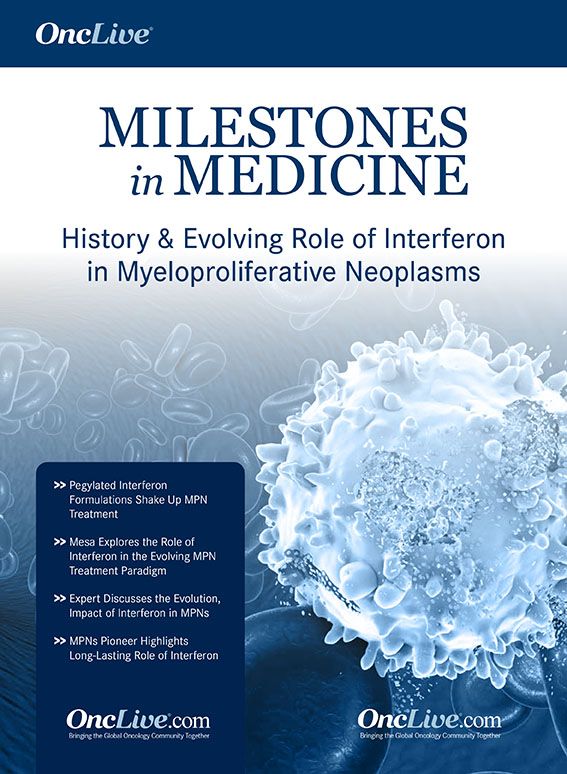Publication
Article
Supplements and Featured Publications
Newer Interferon Agents and Other Novel Treatments Propel MPN Paradigm
Author(s):
Suman A. Kambhampati, MD, discusses emerging data in myeloproliferative neoplasms and what is coming on the horizon.
Suman A. Kambhampati, MD

Suman A. Kambhampati, MD
In myeloproliferative neoplasms (MPNs), next generations of interferon and novel therapies are showing encouraging efficacy signals in patients, which could impact future directions in this patient population, explained Suman A. Kambhampati, MD.
For example, results from the open-label, randomized, phase III MPN-RC 112 trial showcased the similar outcomes between pegylated interferon alfa-2a and hydroxyurea in patients with high-risk polycythemia vera (PV) and high-risk essential thrombocytopenia (ET).1 While complete response rates at 12 and 24 months were similar, pegylated interferon was associated with higher rates of grade 3/4 toxicity.
Moreover, research showcased other agents showing efficacy in patients with myelofibrosis. In an open-label extension study, recombinant human pentraxin-2 molecule PRM-151 alone and in combination with ruxolitinib (Jakafi) was evaluated in patients with myelofibrosis, post-ET/PV myelofibrosis, and grade 2/3 bone marrow fibrosis. Long-term follow-up of the trial, which included 18 patients, showed tolerability of the agent.2
OncLive®: What MPN data were reported at the 2018 ASH Annual Meeting?
In an interview during the 2019 OncLive® State of the Science Summit™ on Hematologic Malignancies, Kambhampati, the co-director of the Blood Cancer Center at Sarah Cannon Cancer Institute, HCA Midwest Health, discussed emerging data in MPNs and what is coming on the horizon.Kambhampati: MPNs [comprise] a very complicated heterogenous disease consisting of many subtypes, and the big thing that came out of the 2018 ASH Annual Meeting was in patients with PV and high-risk ET. Hydroxyurea and pegylated interferon alfa-2a were both equal in terms of responses and toxicity. That study took many years to complete; it was a multi-institutional study and provided robust evidence of usage of hydroxyurea versus pegylated interferon alfa-2a.
The other big theme was data on some novel agents in patients with ruxolitinib-failed myelofibrosis. PRM-151 is one such agent, along with imetelstat, which looks promising. More mature data will tell us how those agents work in ruxolitinib-intolerant or -failed myelofibrosis.
What has been the history of interferon in this paradigm?
How have the different generations of interferon impacted the usage of this drug?
Another new drug called avapritinib looks extremely promising in advanced systemic mastocytosis. The response rates and symptom burden reduction were very impressive with that drug in very early-phase trials. It looks very promising in advanced systemic mastocytosis. Interferon is a naturally occurring cytokine; we all have interferons in our system endogenously. It is supposed to regulate hematopoiesis and [researchers] have studied interferon rigorously over the years; it’s supposed to be a pleotropic cytokine that can inhibit hematopoiesis and also reorganize hematopoiesis in myelofibrosis. It’s an agent that can actually act as a disease modifying agent and has been shown to reduce mutational burden and mutation clearance, thus leading to some deep responses and in patients with MPNs. The most widely used one in the United States is pegylated interferon alfa-2b, and there are different variations of interferon coming in the pipeline. The data again look consistent; [they are] efficacious, but right now the applicability is just relevant to pegylated interferon alfa-2b.
How would you describe the current role of interferon?
What direction do you see interferon going beyond its newer generations?
What other recently presented MPN data would you like to highlight?
Ropeginterferon alfa-2b is another one being investigated. At the 2018 ASCO Annual Meeting, there were some good data presented on that. Those data look to be more mature in 2019 and 2020, which would help us in giving a more tolerable version of interferon. The current role, in terms of early treatment or upfront treatment, looks comparable with hydroxyurea. Those patients who are intolerant to hydroxyurea could be offered interferon. Again, it is a disease-modifying agent that can work across the mutational burden, and also one that can lead to molecular remissions. It is a drug that has promise, but in terms of upfront use it didn’t turn out to be any better than hydroxyurea. The newer versions of interferon and the research coming out of those studies will tell us the future of it. Number one, it’s not that easy to use interferon; the patient tolerance is still a problem. Therefore, the adoption of interferon within community-based practices is pretty limited. Most of these trials are coming out of academic programs, and community practices still have a lot of hesitancy in using interferon over hydroxyurea. The newer, better-tolerated versions of interferon will probably tell us more about the use in community-based settings. Researchers from The University of Texas MD Anderson Cancer Center presented a very elegant study looking at lead-ins of ruxolitinib followed by a combination of ruxolitinib plus azacitidine. That combination produced not only impressive splenic responses, but also bone marrow responses, which I felt were unprecedented. We’ll see how a larger study with that combination would look, but this is something that uses agents we are very comfortable with—both ruxolitinib and azacitidine. These could be promising in untreated patients with myelofibrosis, particularly in those with a high proliferative burden, so that combination could be quite efficacious in that type of MPN.
​​​​​​
References
- Mascarenhas JM, Kosiorek HE, Prchal JT, et al. Results of the Myeloproliferative Neoplasms - Research Consortium (MPN-RC) 112 randomized trial of pegylated interferon alfa-2a (peg) versus hydroxyurea (hu) therapy for the treatment of high risk polycythemia vera (pv) and high risk essential thrombocythemia (et). Presented at: 2018 ASH Annual Meeting; December 1-4, 2018; San Diego, CA. Abstract 577. ash.confex.com/ash/2018/webprogram/Paper111946.html.
- Verstovsek S, Hasserjian RP, Pozdnyakova O, et al. PRM-151 in myelofibrosis: efficacy and safety in an open label extension study. Presented at: 2018 ASH Annual Meeting; December 1-4, 2018; San Diego, CA. Abstract 686. ash.confex.com/ash/2018/webprogram/Paper115362.html.
























%20(2)%201-Recovered-Recovered-Recovered-Recovered-Recovered-Recovered-Recovered-Recovered-Recovered-Recovered-Recovered-Recovered-Recovered-Recovered-Recovered-Recovered-Recovered.jpg?fit=crop&auto=format)
%20(2)%201-Recovered-Recovered-Recovered-Recovered-Recovered-Recovered-Recovered-Recovered-Recovered-Recovered-Recovered-Recovered-Recovered-Recovered-Recovered-Recovered-Recovered.jpg?fit=crop&auto=format)